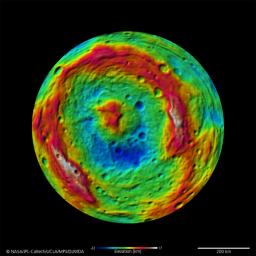
|
A False-Color Topography of Vesta’s South Pole
- Click the image above for a larger view
- Full-Res JPEG (1134 x 1134) (114.1 kB)
- Full-Res TIFF (1134 x 1134) (3.9 MB)
Caption:
This false-color map of the giant asteroid Vesta was created from stereo images obtained by the framing camera aboard NASA's Dawn spacecraft. The image shows the elevation of surface structures with a horizontal resolution of about 750 meters per pixel.
The terrain model of Vesta's southern hemisphere shows a big circular structure with a diameter of about 300 miles (500 kilometers), its rim rising above the interior of the structure for more than 9 miles (15 kilometers.) From low-resolution images of the Hubble Space Telescope it was known that a big depression existed at Vesta's south pole, suggestive of being a big impact basin. Scientists on the Dawn team are still investigating the processes that formed this structure.
Background Info:
The Dawn mission to Vesta and Ceres is managed by NASA's Jet Propulsion Laboratory, a division of the California Institute of Technology in Pasadena, for NASA's Science Mission Directorate, Washington. UCLA is responsible for overall Dawn mission science. The Dawn framing cameras were developed and built under the leadership of the Max Planck Institute for Solar System Research, Katlenburg-Lindau, Germany, with significant contributions by DLR German Aerospace Center, Institute of Planetary Research, Berlin, and in coordination with the Institute of Computer and Communication Network Engineering, Braunschweig. The Framing Camera project is funded by the Max Planck Society, DLR, and NASA/JPL.
More information about Dawn is online at http://www.nasa.gov/dawn and http://dawn.jpl.nasa.gov .
Cataloging Keywords:
| Name | Value | Additional Values |
|---|---|---|
| Target | 4 Vesta | |
| System | Main Belt | |
| Target Type | Asteroid | |
| Mission | Dawn | Hubble Space Telescope (HST) |
| Instrument Host | Dawn | Hubble Space Telescope |
| Host Type | Orbiter | Space Telescope |
| Instrument | Framing Camera (FC) | |
| Detector | ||
| Extra Keywords | Color, Impact, Map | |
| Acquisition Date | ||
| Release Date | 2011-09-16 | |
| Date in Caption | ||
| Image Credit | NASA/JPL-Caltech/UCLA/MPS/DLR/IDA | |
| Source | photojournal.jpl.nasa.gov/catalog/PIA14711 | |
| Identifier | PIA14711 | |
